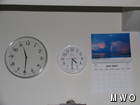Time is…
2007-07-20 23:31:53.000 – Ryan Knapp, Meteorologist
Too much time.
Time on the summit sometimes feels like a riddle, wrapped in a mystery, inside an enigma. I say this because at any given moment, we recognize two to three different times and two different calendars. If you are thinking that the altitude is getting to us, please, let me explain. So let’s start off with time. For those who have toured, visited, or volunteered at Mount Washington Observatory, you know that during the summer we observe three different times. The first is Eastern Daylight Time (EDT) which we call “valley time” since it is the time most of the eastern seaboard recognizes during the summer. The second is in Eastern Standard Time (EST) which is the time we use to know what observations need to be done during our shifts. The last is Greenwich Mean Time (GMT) which is the time that our observations are coded and transmitted in so they coincide with observations taken at the same time around the world. It is confusing for most but second nature to those of us working and living on the summit.
But what is the need for two calendars? Well, the first is the typical calendar you would find hanging in any office or home across the United States. It starts on January first and concludes on December thirty-first. The second one is our climatoligical calendar year. This calendar runs from July first of this year and will conclude on June thirtieth 2008. So with it being July, that means we just started a new year but this also means we just concluded last years records. Let me put it into an analogy like you would find on an SAT test. This calendar is to our station is what a fiscal calendar is to business, it lets us know how we are doing.
So here is the report for the July 2006 through June 2007 climatological year for Mount Washington Observatory. Our average temperature was 31.2 degrees Fahrenheit. Our highest temperature was July 17, 2006 at 69 degrees Fahrenheit. Our lowest temperature was February 6, 2007 and March 6, 2007 at -37 degrees Fahrenheit. We received 94.70 inches which is 7.21 inches below our 30 year mean total. The most we received in a 24 hour period was 4.54 inches. We received 245.6 inches of snow which is 67.0 inches below our 30 year mean total. The most snow we received in 24 hours was 12.3 inches. Our average wind was 38.3 mph. Our highest wind was 158 mph from the west on October 30, 2006 (I remember that one since I was out in it). We had 151 days with peak gusts 73 mph or higher. We had 36 days with winds 100 mph our higher. Lastly, we only received 29 percent of our possible sunshine minutes.
There are other totals but those are the more interesting ones I wanted to share. Interesting stuff but if there is one thing I want you keep in mind about my discussion about time it is this: Time is absolute and relative but never universal.
Ryan Knapp, Meteorologist
Team Flags Return for Seek the Peak’s 25th Anniversary
Team Flags Return for Seek the Peak's 25th Anniversary By MWOBS Staff Mount Washington Observatory is looking forward to continuing a much-loved tradition for Seek the Peak’s 25th Anniversary: Team flags. In inviting teams
Meet Summer Interns Zakiya, Max and Maddie
Meet Summer Interns Zakiya, Max and Maddie By MWOBS Staff We are excited to welcome six teammates to the summit of Mount Washington this summer! During their internship, these students and graduates will play
Saying Goodbye to the Summit
Saying Goodbye to the Summit By Alexis George After an extraordinary last three years working as a Weather Observer and Meteorologist, I am excited to pursue a different career. As sad I as am






